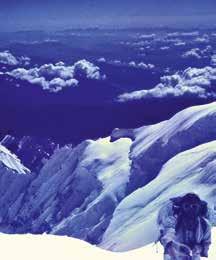
15 minute read
Ex Mountain Dragon
from 6 GR Journal 100
EXERCISE MOUNTAIN DRAGON
ANNAPURNA SOUTH PEAK 1976
After being posted back to 6 GR in Sanctuary, to be our Sirdar and recruit our porters. Hong Kong in 1975 and commanding It was agreed that they would be local villagers A Company, I met up with Captain rather than professional porters and that we would Peter Cooper, Gurkha Engineers, and try hard to look after them. Finance was another established a rock-climbing partnership. We both key issue and we were most fortunate to get the however, had ambitions to climb a “small” peak in support of Ronnie Ross, Frankie Gouldsbury’s father the Himalaya and were encouraged by the success of and a prominent businessman in Hong Kong who the Hong Kong Expedition provided a vital interface to Lamjung Himal in 1974 with local companies who which had included Frank might support us. As well Fonfe from 6 GR. After as financial support we considerable research and on received help in kind with the advice of Jimmy Roberts such things as clothes and in Pokhara, we opted for blankets which we were Annapurna South Peak (ASP) later able to pass on to our at 23,683 feet (7,219 metres) porters. I also contracted by the East Face from the to do some articles for the Annapurna Sanctuary and Sunday South China Morning in the post monsoon period, Post (SCMP). i.e. September to November. The mountain had only been With the very positive climbed twice before and support of Mike Wardroper, only once via the East Face then Commanding Officer and, at that height, would 6 GR, Corporal Rinchen mean that we would not Wangdi Lepcha, Rifleman need oxygen. Peter carrying a load using fixed ropes on Dhanbahadur Pun and our Serac Ridge attached PTI, Staff Sergeant Permissions were sought Rick Broad and myself were and eventually received, the mountain booked, but all released for the expedition. WO2 Li Nai Chung then the Nepalese authorities changed the rules from the School of Physical and Recreational Training and only through the splendid efforts of the Defence in Hong Kong made the lead climbers up to 6. Support Attaché were we able to continue. There was much climbers were Lance Corporal Martin Callaghan to do; finance, equipment, rations, flights, personnel from the Light Infantry and Rifleman Sukrabahadur etc, etc: 1976 became an extremely busy year for Rai from 1/2GR with Sergeant Bill Noble from 18 Peter and myself. One of the key issues was porters, Field Ambulance in Sek Kong as our medic. Rifleman as the Lamjung expedition’s porters had walked Rasbahadur Gurung, 6 GR, and Sapper Belbahadur out and nearly scuppered the whole thing. In the Gurung, Gurkha Engineers, who were both to be on spring of 1976, Ria my wife, and I did a recce to the leave agreed to act as our mail runners. With four of mountain and also persuaded Honorary Lieutenant the six lead climbers, the Sanbahadur Gurung, a former 6 GR RSM and resident Sirdar and one mail runner, this had become very of the village of Chhomro, the last village before the much a 6 GR expedition!
Rick and I formed the Advance Party and we arrived in Kathmandu on 16 September. Bob Duncan 6 GR, then Acting Defence Attaché did an outstanding job helping us through the bureaucratic minefield we encountered at the Nepalese Ministry of Foreign Affairs, the Customs etc. I left for Pokhara on 20 September and Rick joined me in the British Gurkha Camp a couple of days later arriving by truck with all our kit. The porters arrived in the camp on the 22nd and Sanbahadur Saheb had done a magnificent job. 65 men from the Chhomro area organised into 6 teams each commanded by a “naik” who also carried a load, but was paid more and was responsible for his team. They collected their loads and clothing and we certainly had the best dressed porters of 1976. Rick and I had a wonderful walk in; the porters were great fun and we made lots of friends. Our night stay in Chomro was particularly memorable and we were made extremely welcome. We arrived at Base Camp in the Sanctuary, where the lodges now stand, on 27 September in a blizzard and unpacked the porters loads as quickly as possible. The following day the main body arrived in sunshine and we began the expedition proper.
While sitting in my tent door looking up at the mountain it struck me just what a challenge we had taken on. Only Rinchen had limited Himalayan experience, Peter had done a couple of seasons in the Alps and so was the most experienced, Rick and I had virtually no snow and ice experience; Dhanbahadur none, and Li, despite being a very good rock climber, had never even seen snow! It was going to be quite an adventure.
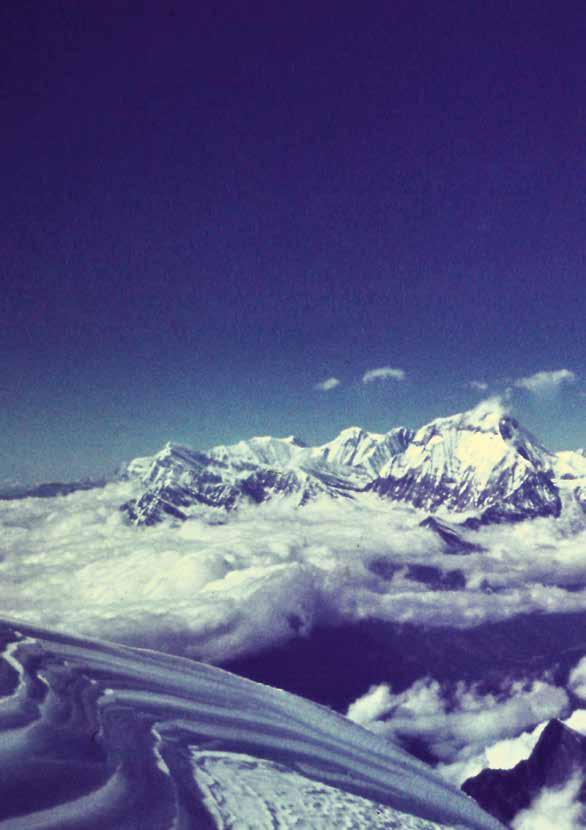
After sorting our kit and doing some snow and ice instruction, introducing many to their ice axes and how to use them, we tried to push a route up the left and around the top of the glacier running between Hiunchuli and ASP. After finding a suitable place for
Summit photo looking west towards Dhaulagiri, 8,167m
Camp 1 the going across the glacier proved extremely difficult; it was heavily crevassed and threatened with avalanches from Hiunchuli. After six days we abandoned this option and over the next few days established a longer route below the snout of the Hiunchuli-ASP glacier and then up the right-hand side. We had formed into three teams of two, Peter and Rick, Rinchen and Dhanbahadur and Li and me. One team would do the lead climbing, supported with carries by the other two teams. We had no porters above Base Camp and carried all our own loads to establish camps and the route.
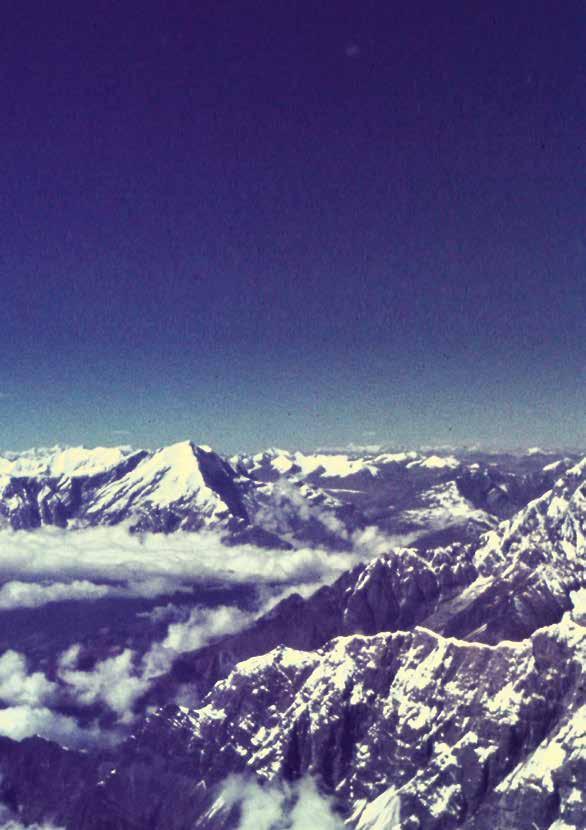
By 11 October we had established Camp 2 at 17,500 feet well up on the glacier but below a significant fault line of crevasses, large ice seracs and some rock. It formed a real barrier and it was not until 18 October with two teams on the case that we had found a way through this. The route was dangerous though, with stones flying down after about 10 am. Also, we needed to fix a rope over a steep rocky buttress using a “dead man” snow anchor. This meant that all loads above Camp 2 had to be hauled up the 120-foot buttress and we personally had to climb the rope by prussiking and then abseil on the way down. All pretty hard work at over 18,000 feet. Camp 3 was established on 18 October above the barrier and at the foot of what we called Serac Ridge. This was a steep ridge alternating between reasonable snow fields and then ice cliffs ranging between 50 and 100 feet in height and which led to the summit ridge of ASP.
I tried to send regular reports to Hong Kong for the SCMP. These were usually written in pencil on a shorthand pad in my tent, carried down to Base Camp by whoever was going down and then sent with my unprocessed slide film with one of our mail runners, taking three days from Base Camp to Pokhara. It was then British Forces Post to my wife in Hong Kong. She tried to decipher my scribble and type it out as well as choosing relevant photographs from the films before submitting it to the SCMP. Quite a contrast to
Niligiri Tilicho
Grand Barrier
Annapurna I 25,602
TILICHO LAKE
Angapurna
Glacier Dome
0
Marang
Kilometres
MARSYANGDY KHOLA
Annapurna III
24,858 10
Annapurna South Peak 23,607
Chomro KYUMNI KHOLA
Hiunchuli
Hinko Cave
Kuldi
MODI KHOLA
Machhapuchhre
22,956
Ghan drung
Landrung
SETI KHOLA
Birethanti Chandrakot
Lumle Dhampus Suikhet
Nau Danda Siklis
MADI KHOLA
Pokhara
Map of the area and route of the walk in
today’s instant communications! In the middle of one night at Camp 2, we heard noises outside our tent. We knew no one else was on the mountain, but the noise of rustling in our supply dump outside the tent got louder. I shrank even further into my sleeping bag; the effort of getting dressed and going outside in the intense cold was unthinkable. Eventually the noises stopped and we went back to sleep. In the morning
BC I
MAIN ANNAPURNA GLACIER
GLACIER SNOUT ANNAPURNA/HIUNCHULI GLACIER
II
Left Nostril
Right Nostril

III
V
SERAC RIDGE
IV
Annapurna South Peak
23,607
Route taken by Exercise Mountain Dragon
we found that the supply dump had been significantly disturbed and there were large cat foot prints in the snow. We assumed that we had been blessed with a visit from a Snow Leopard! The day we established Camp 3 we had an interesting event when a group from the UK Rambler’s Association arrived at Base Camp and one of their number collapsed and lost consciousness.
Rinchen and Duncan with Machhapuchare, Annapurna II and IV in the background
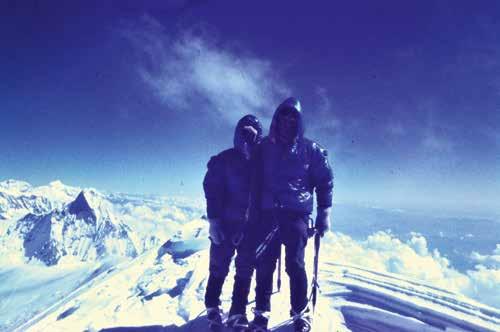
Bill, our medic reacted quickly, administered oxygen and the man recovered. The Rambler’s doctor was at our Camp 1 having volunteered to do a carry for us! The following day Rinchen started suffering from snow blindness which was relieved with drops carried up from Base Camp by Martin. A day later in the early hours of 22 October, Camp 3 was hit by the tail end of an avalanche. The tent was rolled over 10 metres and partially buried. It ended close to a crevasse! Peter and Rick managed to recover their composure and move the tent further away from the crevasse and repitch it, but valuable stores were lost.
Camp 4, part way up Serac Ridge was finally established at about 20,500 feet on 23 October and occupied by Peter and Rick. The next three days of significant fresh snow were most frustrating and little progress was made. Li and Dhanbahadur became ill and moved back to Base Camp and so Rinchen joined me at Camp 3. Prior to that I had suffered probably the most difficult day of my life, carrying a double load through the fresh snow from Camp 3 to Camp 4, knowing that Camp 4 was short of supplies.
By 28 October a site for Camp 5 had been found, pushing up through some interesting steep sections, but Rick had pulled a tendon in his leg and needed to go down. Rinchen and I joined Peter at Camp 4 and on 31 October the three of us occupied Camp 5 at around 21,500 feet. We still had over 1,000 feet of steep, but good climbing on steep and sometimes vertical water ice and on 1 November we gained about 800 feet and fixed some ropes. We decided to go for it the following day, but took our sleeping bags, duvet jackets plus a stove and some food just in case. It was slow going; we had all been at over 17,000 feet for well over two weeks without a break. We pressed on beyond our high point, but at around 200 feet below the summit ridge we stopped at a small crevasse and decided to set up a bivouac. I stayed there to build the bivouac under an overhanging roof while Peter and Rinchen completed the route to the summit ridge. It was an
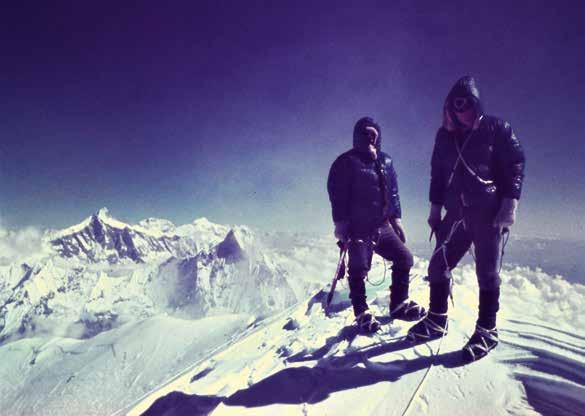
Peter and Rinchen with Machhapuchare, Annapurna II and IV in the background
uncomfortable night at 23,000 feet sitting on a snow bench, but thankfully in our sleeping bags.
The following day, 3 November, we started late, after the summit ridge but were hit by a viciously cold wind. The snow was difficult too as we often broke through the crust making walking really hard work. It took over three hours to reach the summit, but from there at 13:00 we had the most amazing views of the surrounding mountains and into the far distance; we really did feel as if we were on the top of the world. By this stage Rinchen was suffering from exposure and he struggled on the way back down the ridge. Peter did a wonderful job looking after him as I was also in poor shape. We decided a descent to Camp 5 was too much for Rinchen, who by this time had also lost a crampon, so having made it to the bivouac we put him in all three sleeping bags until he recovered. Peter and I realised he was OK when Rinchen was sick; but he carefully avoided being sick on the sleeping bags; clearly he would survive! We then spent another night sitting on our uncomfortable bench, but in relative warmth and with luke warm tea as the water at that height boils at much less than
the sun had hit the bivouac. We quickly climbed to 100 degrees Celsius.
The following day we dropped down to Camp 5, only to find that our tent, with radio and other kit had been blown away. There were some rations however, and we had our first real meal for over two days. Later that day we got to Camp 3, clearing the mountain as we went and were able to radio Base Camp. We had been out of contact for over three days and they had given us up for lost. At least that was how it seemed when we discovered that they had already called up the porters to evacuate Base Camp. From Camp 3, Peter went ahead and I followed on with Rinchen, who was struggling a bit with only one crampon. We jumped over the crevasses on the glacier, feeling very fit in the oxygen rich air. At one wider crevasse I threw my pack over first, only to see it continue to roll and disappear into the next crevasse. This was not good; as apart from my kit, my
Peter and Rinchen recovering with some welcome food at Camp 5, minus tent!!

pack included my camera with the pictures taken on the summit!! Together, Rinchen and I did a crevasse rescue; it was a scary feeling abseiling deep into a cold blue crevasse, but I made it out and we carried on. As we left the glacier Rinchen stopped and in a small ice cave made a small cairn. He then knelt and gave thanks for our safe deliverance from the mountain. I joined him in the short ceremony; it was very moving. Back at Base Camp that evening we had a barbeque and campfire and finally left the Sanctuary with our now small band of porters the next day on 7 November. We had been there six weeks.
We had a small problem though; what to do with Kanchi? Kanchi was a chicken that Rasbahadur’s mother had given me on the walk in for our supper on the night after we left Chomro. That night though we were cold and tired and ate tinned rations so the chicken returned to the top of the porter’s basket. The chicken was forgotten about in the rush for the porters to leave Base Camp and we found her the following day wandering around the camp. She adopted a place in the Base Camp kitchen and we fed her on scraps. Foolishly, I named her Kanchi. She became very tame, perching on people’s shoulders and I decided to kill her at Dashera. Sadly, I was up the mountain over Dashera and as she was mine no one else would kill her. I wanted to kill her for the last night at Base Camp, but many other members objected as she had become the expedition mascot and pet so I decided to take her back to Chomro.
Before we left Base Camp, now with many fewer porters, we distributed all our unused rations, mainly in tins, to our porters, with the clear instructions to ask us if they were unsure of the contents. I had only walked about 400 metres when I found a porter sitting with an opened tin; using his fingers he was sampling the contents and screwing up his face. I stopped and examined the tin: Army Rations Mock Turtle Soup Powder! I couldn’t help laughing but did explain how best to eat it.
The team, garlanded and leaving Chomro. L to R: Rasbahadur, Lt Hirabahadur (Liaison Officer), Rasbahadur’s brother, Lee, Dhanbahadur, Bill, Rick, Martin, Peter, Sanbahadur Sahib
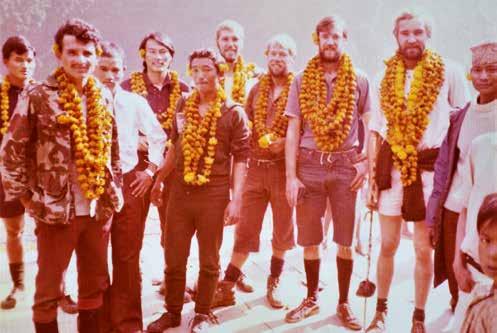
On the walk out as we entered Chomro we were met and all garlanded by Rasbahadur’s mother and we returned Kanchi. I explained what had happened and although I am sure that she understood every word that I said, there was an unmistakeable look of disbelief in her eyes. A big party was held that night with plenty of raksi and dancing and many of our walk-in porters came to see us and wish us well. We continued our walk out and were greeted in a number of 6 GR houses. I walked out in my large double boots to protect my frost-bitten toes; walking was quite difficult with no feeling in my feet. We met many trekkers on the walk out, all of whom had heard of our success and the constant question was “Did you get to the top”. I answered in the positive and we chatted about the experience but as I hobbled off down the track I could see them look at me, stumbling over small rocks and then look up to the mountain and shake their heads. All told, we felt that the expedition had been a great success and we had the satisfaction of knowing that we had worked hard together and achieved our aim of getting to the top. We had been extremely privileged to spend over 6 weeks in the Annapurna Sanctuary, surely one of the most beautiful and spiritual places in the world. No one had been seriously injured, and once we returned to Hong Kong we realised that we had managed to make a small profit. This we donated to the Army Mountaineering Fund set up in the names of those killed on the 1975 Nuptse Expedition, many of whom had been friends. We thought that conditions had been hard, but nothing like the deprivations suffered by the previous generation and we were very fortunate with the one thing you cannot control, the weather. For me it had been extremely hard work setting up the expedition with Peter, but the expedition still rates as the best and most fulfilling adventure in a reasonably adventurous life.










